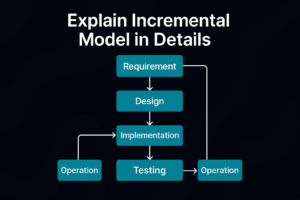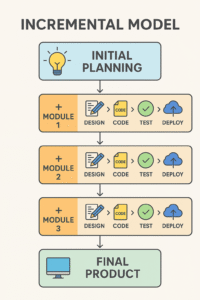Explain incremental model in details.
Incremental Model

Definition:
The Incremental Model is a software development model where the system is developed in parts or pieces (called increments). Each increment adds new features or improvements to the existing software.
With every new increment, the software becomes more complete until the final full product is ready.
The Incremental Model is a software development approach where the entire system is divided into smaller modules (increments) and developed step-by-step. Each increment is a part of the final system that is designed, developed, tested, and delivered one after another.
The first increment contains the core features, and each following increment adds new features or improvements until the full software is complete.
Key Points in the Definition:
The full software is not built all at once, but in small parts.
Each part (increment) is independently built and then combined with the previous parts.
After each increment, the software is usable and tested.
The model allows frequent user feedback and changes during development.
It is a combination of waterfall and iterative approach — with linear planning but flexible building.
Objectives of the Incremental Model:
- To deliver partially working software quickly, even if the full system is not ready.
- To reduce risk by dividing work into smaller sections.
- To allow early feedback and easier error fixing.
- To allow flexible changes during development.
Features of the Incremental Model:
- Software is built and delivered in parts, not all at once.
- Each part is fully developed and tested before moving to the next.
- Earlier increments are reused and improved in future ones.
- User feedback is collected after each increment.
- Cost-effective and time-saving approach.
Phases of the Incremental Model (Step-by-Step)

1. Requirement Gathering:
- Collect basic requirements that apply to all parts of the system.
- Break the overall system into smaller modules or increments.
2. Design Phase:
- Design the overall architecture.
- Plan how each module will connect with others.
- Create design diagrams for each increment.
3. Implementation (Coding):
- Code and build the first module (increment).
- Once complete, move to the next increment, and so on.
- All parts are coded separately but built on top of the previous one.
4. Testing:
- Each increment is tested for errors.
- Integration testing is done to ensure all parts work together.
5. Deployment:
- Each working module can be delivered to the client one-by-one.
- Early versions are released before the full system is ready.
6. Maintenance:
- Fix bugs, update features, and maintain older increments.
- Add new features in future increments as needed.
Advantages of the Incremental Model:
- Early delivery of working software.
- Easy to identify and fix errors early.
- Flexible – changes can be added in later increments.
- Lower risk than building everything at once.
- Suitable for projects with changing requirements.
- Easy testing and easy management.
Disadvantages of the Incremental Model:
- Needs good planning and design.
- Each increment must be well-integrated with the previous ones.
- Total cost may be higher if too many increments are added.
- Not suitable for projects with very fixed and full requirements from the start.
Best Use Cases for the Incremental Model:
- Projects where early delivery is important.
- Software where core features are clear, but more features may be added later.
- Web applications, mobile apps, and e-commerce platforms.
- Projects with budget or time limits.
🔷 Incremental Model क्या है?
परिभाषा (Definition):
Incremental Model एक ऐसा सॉफ़्टवेयर डेवलपमेंट मॉडल है जिसमें पूरा सिस्टम एक साथ नहीं बनाया जाता, बल्कि छोटे-छोटे हिस्सों (increments) में बनाया जाता है।
हर नया हिस्सा पहले से बने हिस्से में जुड़ता है और सॉफ़्टवेयर धीरे-धीरे पूरा होता जाता है।
इस मॉडल में पहले core features बनाए जाते हैं, फिर हर step में नए features या सुधार (improvements) जोड़े जाते हैं।
मुख्य उद्देश्य (Objectives):
- शुरू में ही usable software देना, भले ही पूरा सिस्टम न बना हो।
- बड़े प्रोजेक्ट को छोटे manageable टुकड़ों में बाँटना।
- यूज़र का जल्दी फीडबैक लेना और उसी के अनुसार सुधार करना।
- रिस्क (Risk) को कम करना।
- समय और लागत दोनों को सही ढंग से मैनेज करना।
मुख्य विशेषताएँ (Features):
- सॉफ़्टवेयर टुकड़ों में बनाया जाता है।
- हर पार्ट को अलग से design, develop और test किया जाता है।
- हर नया increment पिछले वाले में जुड़ता है।
- यूज़र फीडबैक हर स्टेप पर लिया जाता है।
- Cost-effective और easy-to-manage approach होती है।
🔁 Incremental Model के चरण (Phases):
1️⃣ Requirement Gathering (जरूरतें इकट्ठा करना):
- पूरी सिस्टम की बेसिक ज़रूरतें पता करना।
- सिस्टम को छोटे-छोटे modules (increments) में divide करना।
2️⃣ Design Phase (डिज़ाइन चरण):
- पूरे सिस्टम की structure बनाना।
- हर module को कैसे जोड़ा जाएगा — इसका plan बनाना।
- Diagrams और documents तैयार करना।
3️⃣ Implementation Phase (कोडिंग):
- पहले increment का कोड लिखा जाता है।
- फिर अगले increment का कोड लिखा जाता है — पिछले के ऊपर।
- सब modules अलग-अलग होते हैं लेकिन आपस में जुड़े होते हैं।
4️⃣ Testing (परीक्षण):
- हर increment का testing किया जाता है।
- Integration Testing — सारे modules मिलकर काम कर रहे हैं या नहीं।
5️⃣ Deployment (तैनाती):
- हर working module को client को दिया जा सकता है।
- Client को पूरा सिस्टम मिलने से पहले usable software मिल जाता है।
6️⃣ Maintenance (रख-रखाव):
- Bugs को fix करना।
- पुराने features को update करना।
- Future में नए features जोड़ना।
फायदे (Advantages):
- जल्दी usable product तैयार।
- Errors जल्दी पकड़े जाते हैं और सुधारे जाते हैं।
- Flexible – बाद में features जोड़े जा सकते हैं।
- Risk कम रहता है।
- Changing requirements वाले projects के लिए बढ़िया।
नुकसान (Disadvantages):
- Planning और Design strong होना ज़रूरी है।
- हर increment को सही से integrate करना पड़ता है।
- ज़्यादा increments से cost बढ़ सकती है।
- Fix और rigid requirement वाले projects के लिए उपयुक्त नहीं।
Incremental Model का Best Use कब करें?
- जब जल्दी usable version चाहिए।
- जब ज़रूरतें पूरी तरह से clear न हों और future में बदल सकती हों।
- Web applications, mobile apps, ecommerce projects के लिए बढ़िया।
- Budget या time constraints हों।